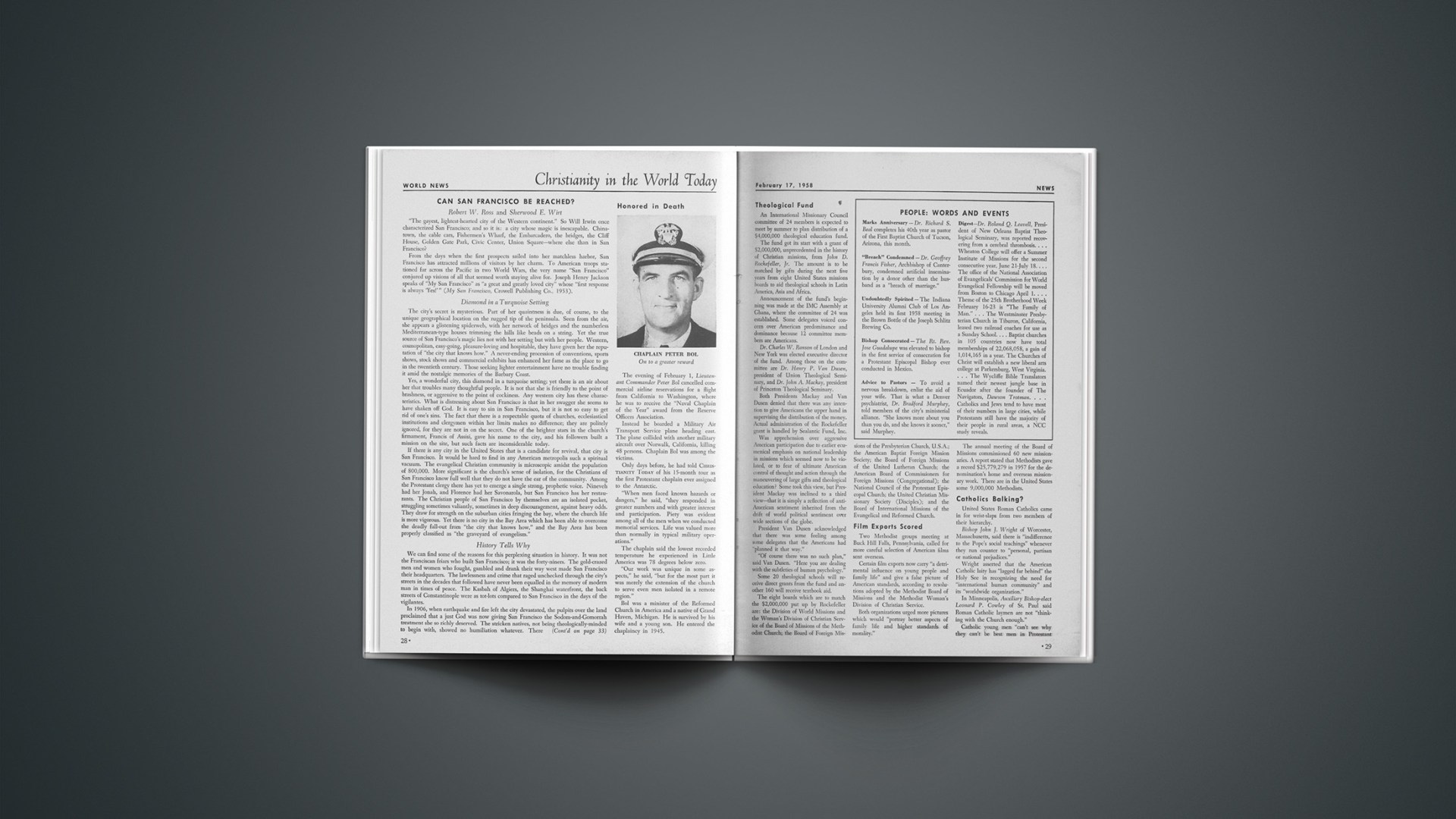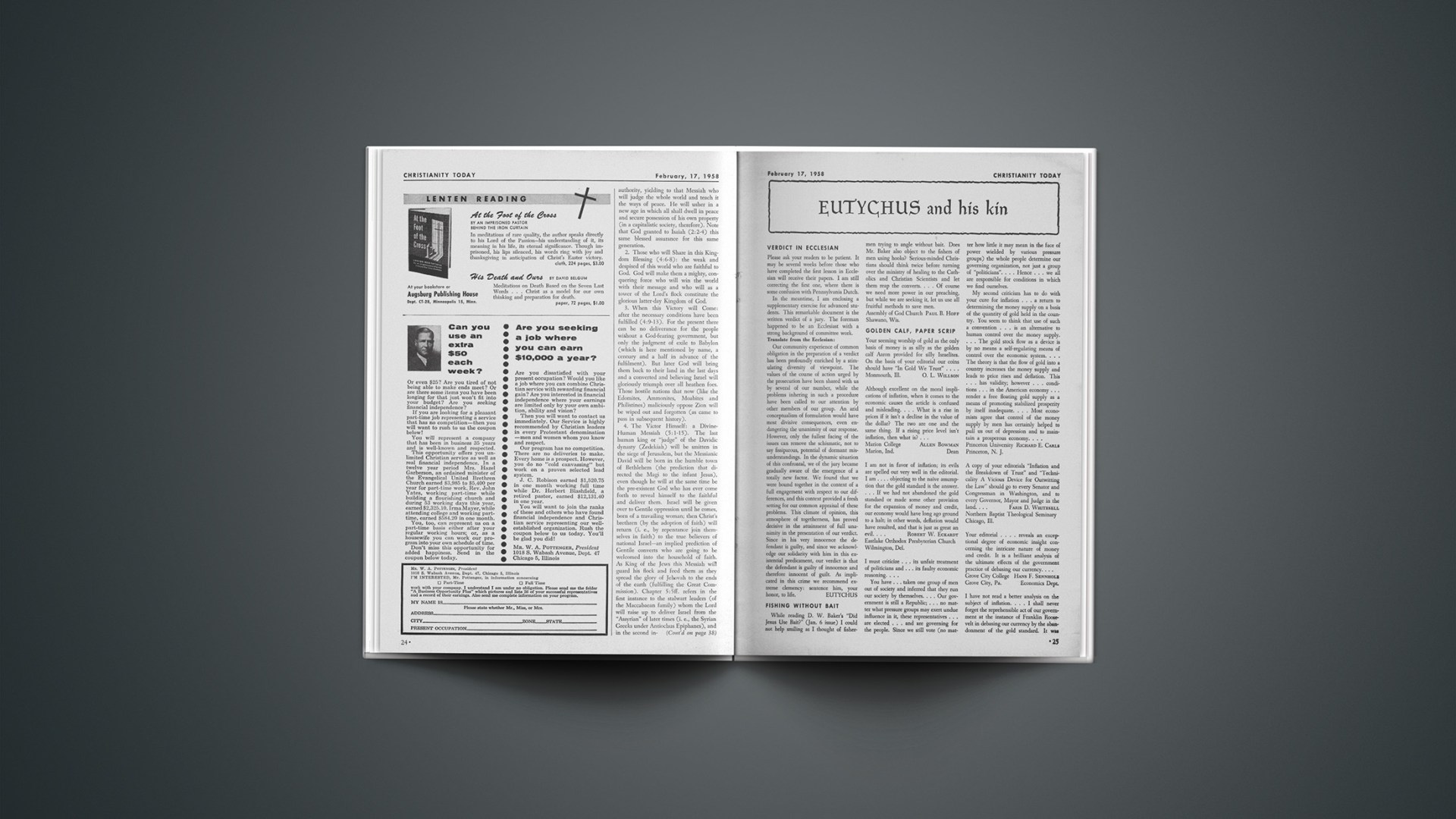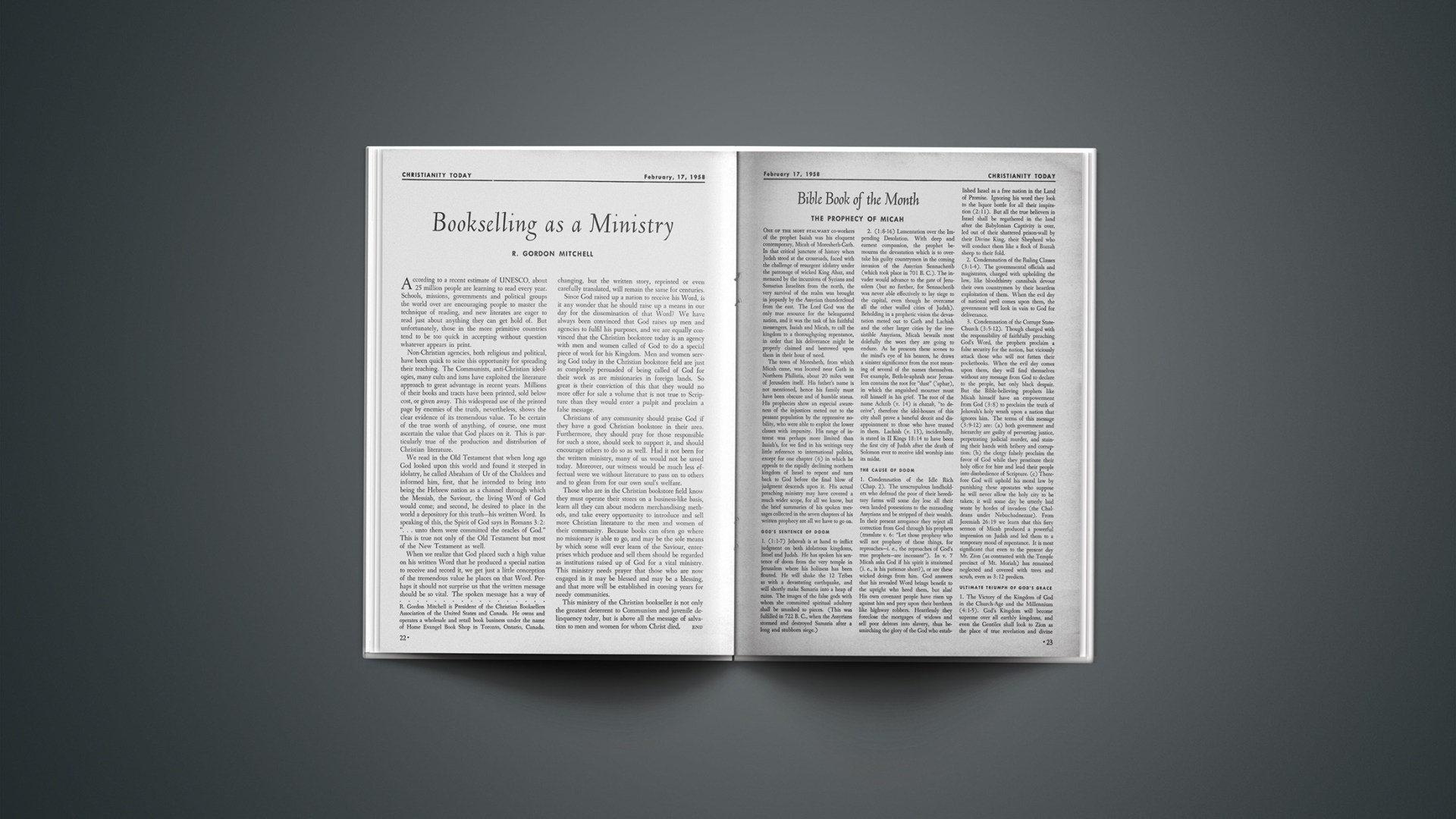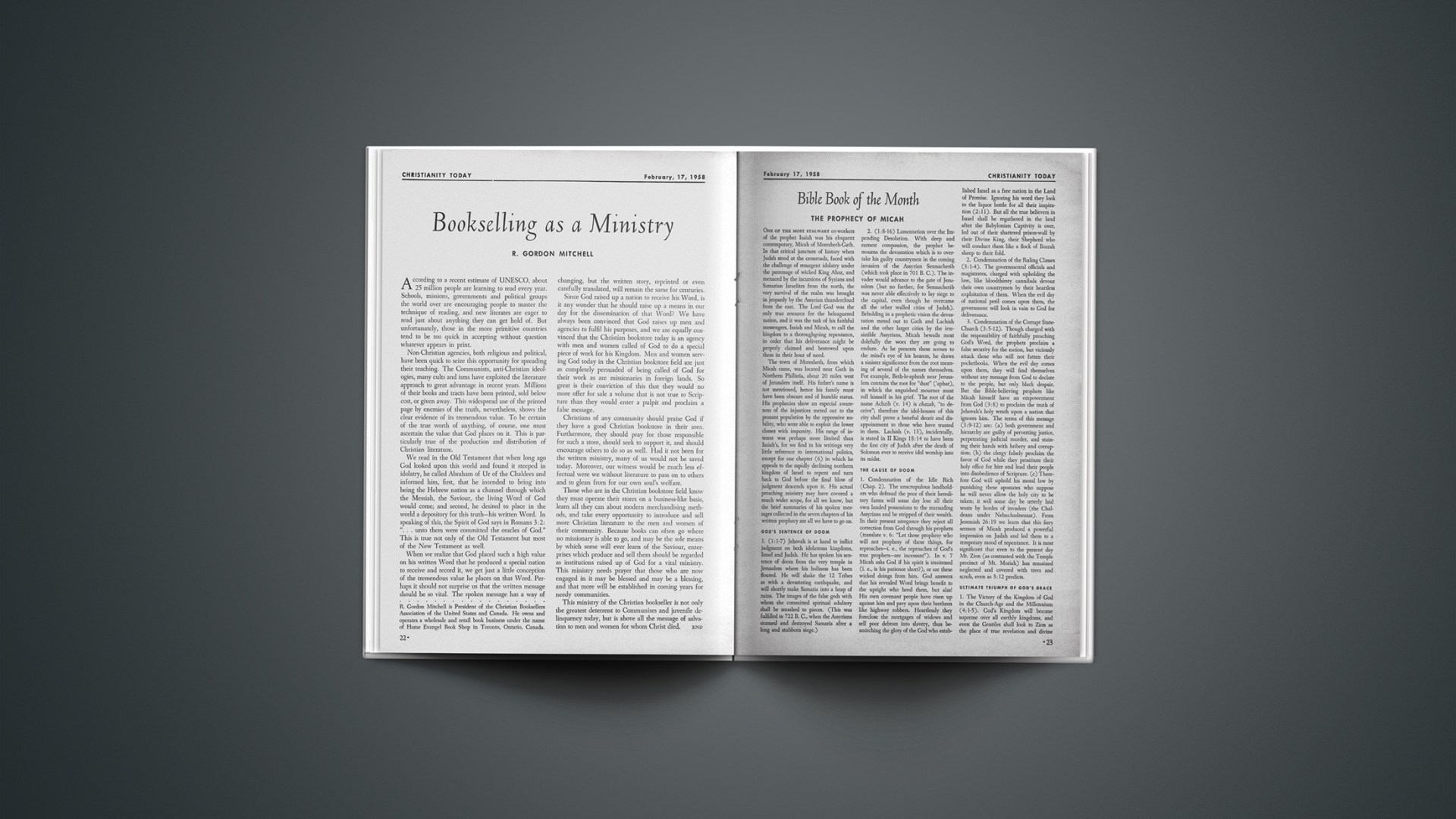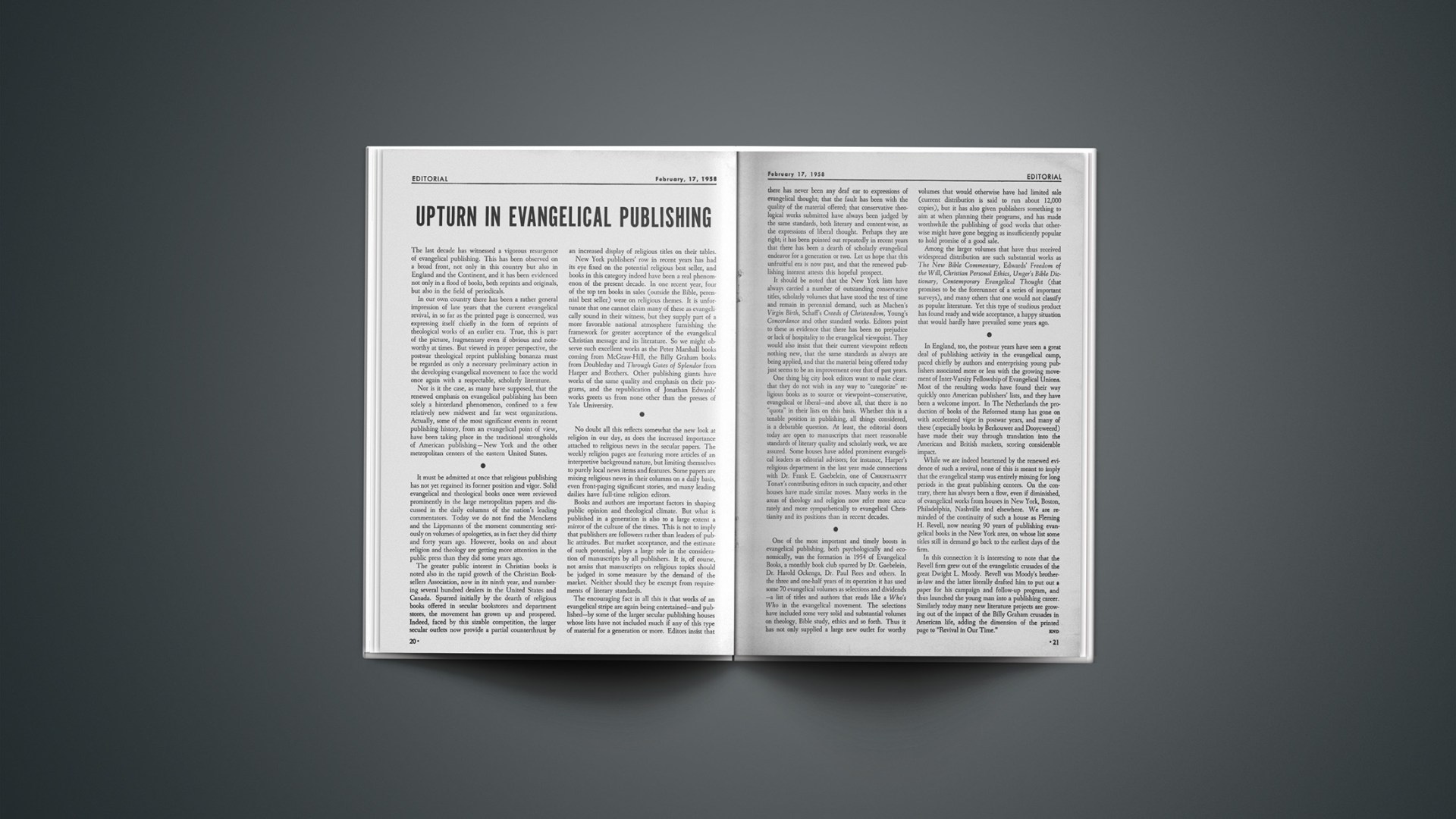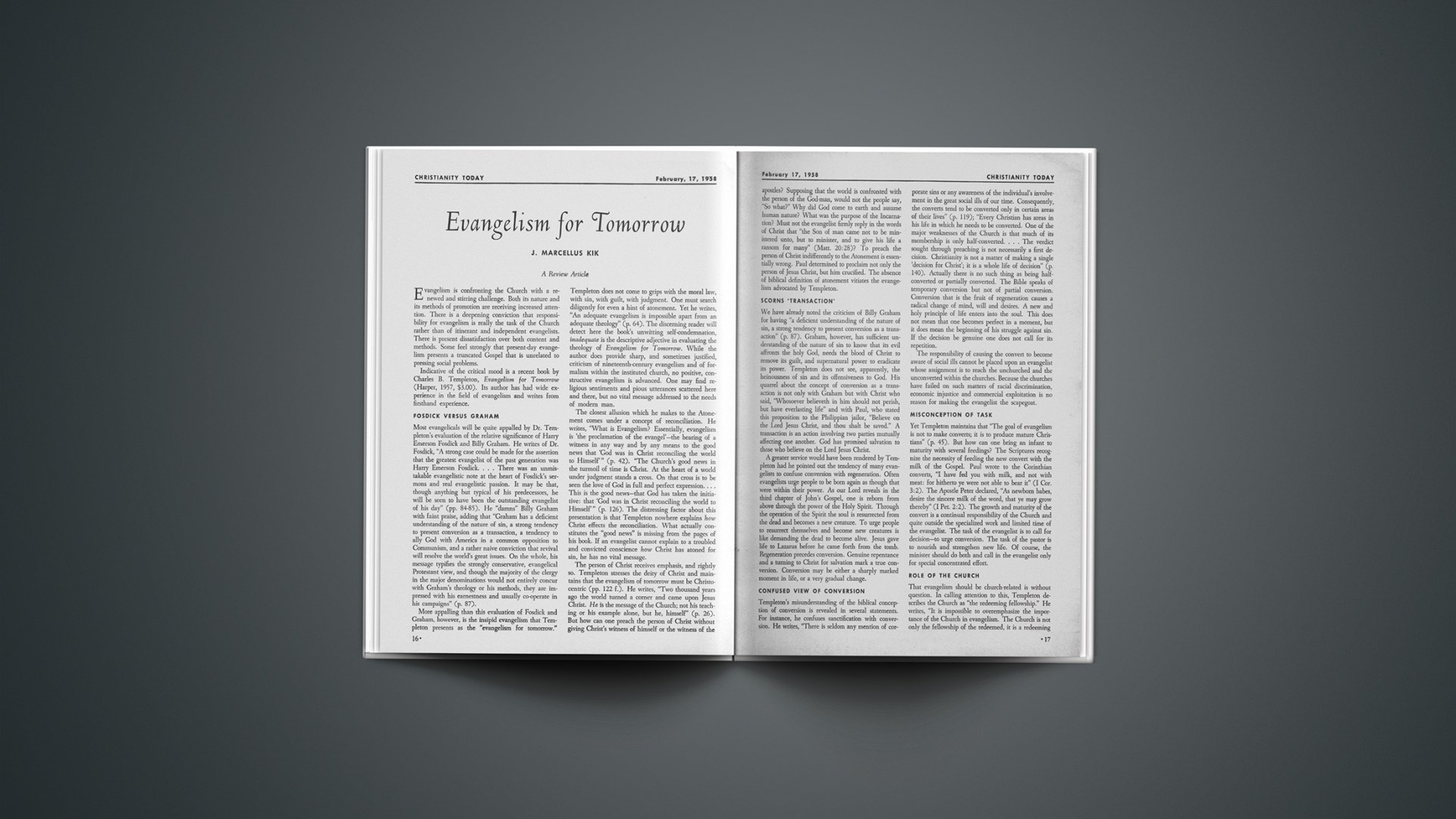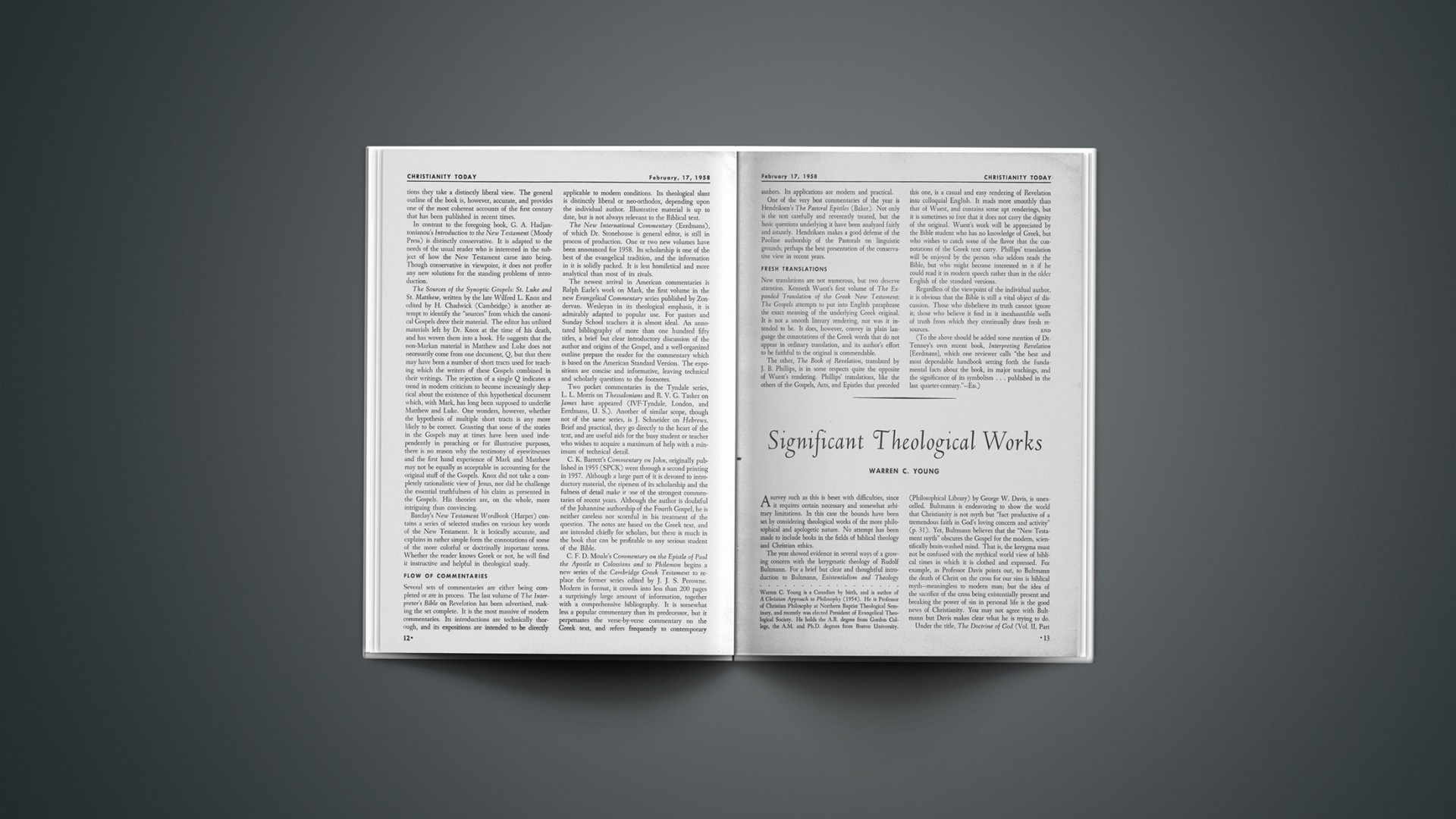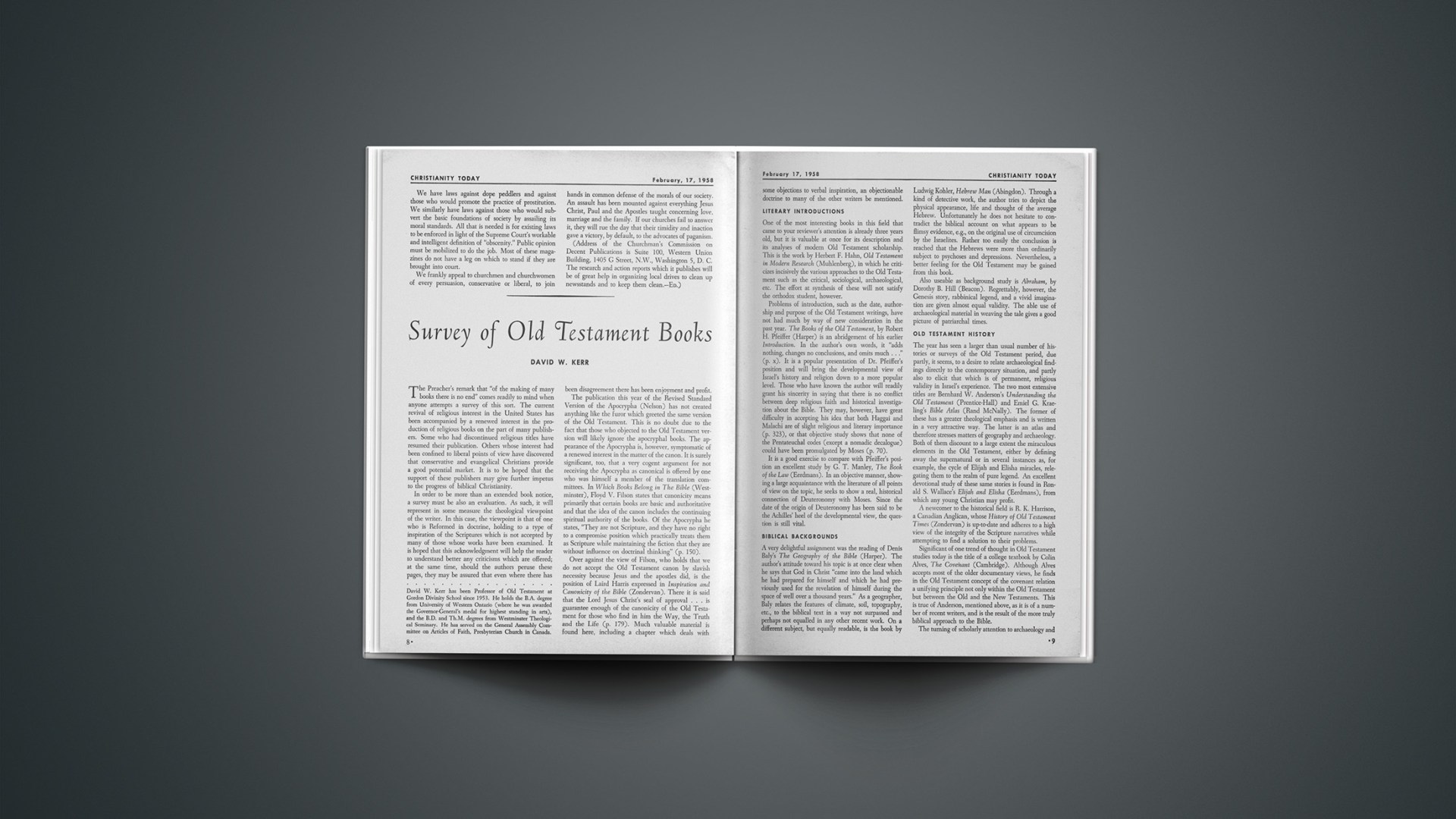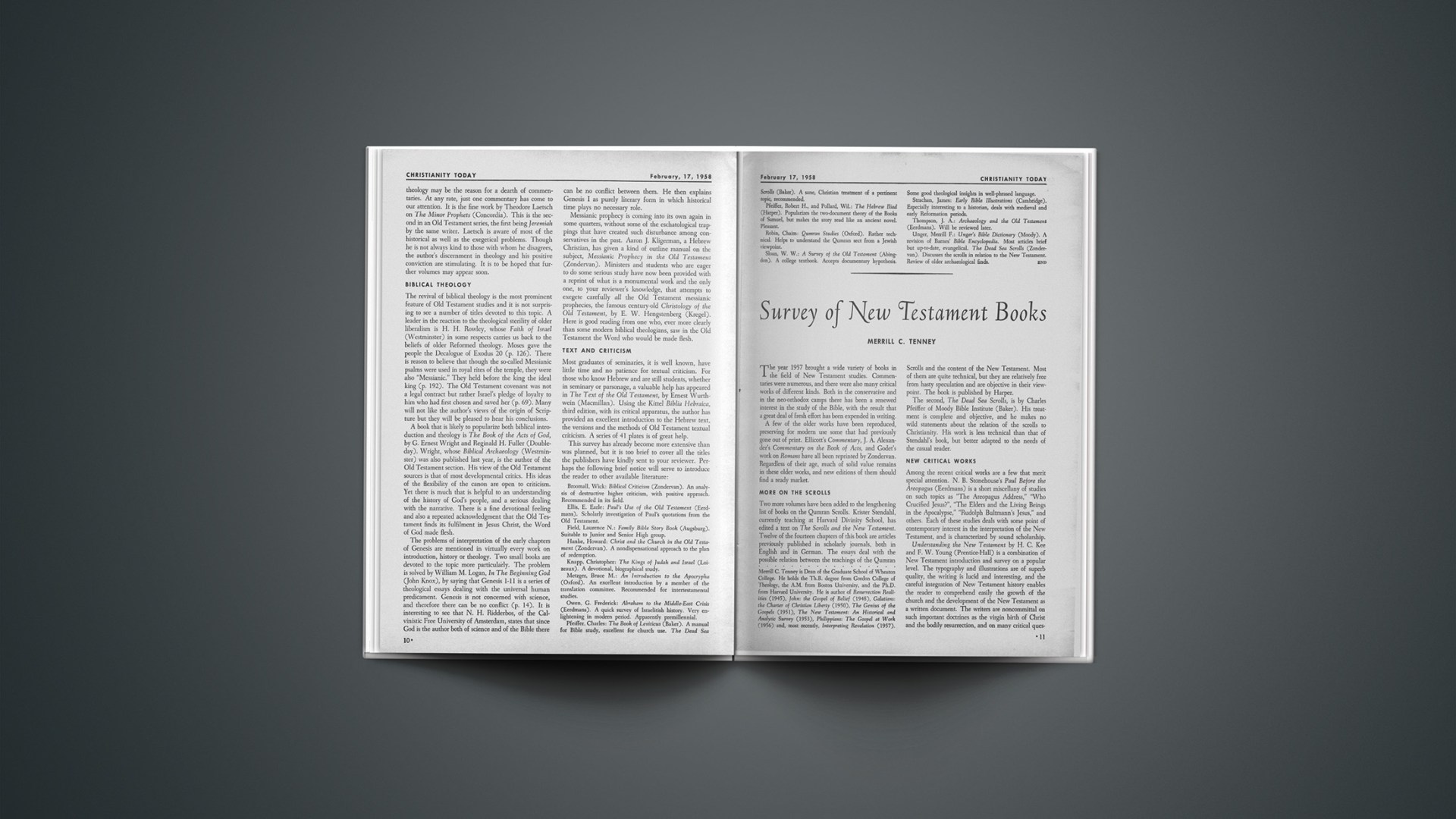WORLD NEWS
Christianity in the World Today
Robert W. Ross And Sherwood E. Wirt*
“The gayest, lightest-hearted city of the Western continent.” So Will Irwin once characterized San Francisco; and so it is: a city whose magic is inescapable. Chinatown, the cable cars, Fishermen’s Wharf, the Embarcadero, the bridges, the Cliff House, Golden Gate Park, Civic Center, Union Square—where else than in San Francisco?
From the days when the first prospects sailed into her matchless harbor, San Francisco has attracted millions of visitors by her charm. To American troops stationed far across the Pacific in two World Wars, the very name “San Francisco” conjured up visions of all that seemed worth staying alive for. Joseph Henry Jackson speaks of “My San Francisco” as “a great and greatly loved city” whose “first response is always ‘Yes!’ ” (My San Francisco, Crowell Publishing Co., 1953).
Diamond In A Turquoise Setting
The city’s secret is mysterious. Part of her quaintness is due, of course, to the unique geographical location on the rugged tip of the peninsula. Seen from the air, she appears a glistening spiderweb, with her network of bridges and the numberless Mediterranean-type houses trimming the hills like beads on a string. Yet the true source of San Francisco’s magic lies not with her setting but with her people. Western, cosmopolitan, easy-going, pleasure-loving and hospitable, they have given her the reputation of “the city that knows how.” A never-ending procession of conventions, sports shows, stock shows and commercial exhibits has enhanced her fame as the place to go in the twentieth century. Those seeking lighter entertainment have no trouble finding it amid the nostalgic memories of the Barbary Coast.
Yes, a wonderful city, this diamond in a turquoise setting; yet there is an air about her that troubles many thoughtful people. It is not that she is friendly to the point of brashness, or aggressive to the point of cockiness. Any western city has these characteristics. What is distressing about San Francisco is that in her swagger she seems to have shaken off God. It is easy to sin in San Francisco, but it is not so easy to get rid of one’s sins. The fact that there is a respectable quota of churches, ecclesiastical institutions and clergymen within her limits makes no difference; they are politely ignored, for they are not in on the secret. One of the brighter stars in the church’s firmament, Francis of Assisi, gave his name to the city, and his followers built a mission on the site, but such facts are inconsiderable today.
If there is any city in the United States that is a candidate for revival, that city is San Francisco. It would be hard to find in any American metropolis such a spiritual vacuum. The evangelical Christian community is microscopic amidst the population of 800,000. More significant is the church’s sense of isolation, for the Christians of San Francisco know full well that they do not have the ear of the community. Among the Protestant clergy there has yet to emerge a single strong, prophetic voice. Nineveh had her Jonah, and Florence had her Savonarola, but San Francisco has her restaurants. The Christian people of San Francisco by themselves are an isolated pocket, struggling sometimes valiantly, sometimes in deep discouragement, against heavy odds. They draw for strength on the suburban cities fringing the bay, where the church life is more vigorous. Yet there is no city in the Bay Area which has been able to overcome the deadly fall-out from “the city that knows how,” and the Bay Area has been properly classified as “the graveyard of evangelism.”
History Tells Why
We can find some of the reasons for this perplexing situation in history. It was not the Franciscan friars who built San Francisco; it was the forty-niners. The gold-crazed men and women who fought, gambled and drank their way west made San Francisco their headquarters. The lawlessness and crime that raged unchecked through the city’s streets in the decades that followed have never been equalled in the memory of modern man in times of peace. The Kasbah of Algiers, the Shanghai waterfront, the back streets of Constantinople were as tot-lots compared to San Francisco in the days of the vigilantes.
In 1906, when earthquake and fire left the city devastated, the pulpits over the land proclaimed that a just God was now giving San Francisco the Sodom-and-Gomorrah treatment she so richly deserved. The stricken natives, not being theologically-minded to begin with, showed no humiliation whatever. There may have been ashes, but there was no sackcloth. They proceeded to build a bigger, brassier city than ever, with a bigger brassier Barbary Coast. The poet Vachel Lindsay took a look at the new city, boasting its magnificent recovery at the 1915 Panama-Pacific International Exposition, and shook his head in a poem entitled, “The City That Would Not Repent” (General William Booth and Other Poems, Macmillan, 1924, p. 8):
God loves this rebel city,
Loves foemen brisk and game.
Tho’, just to please the angels,
He may send down his flame.
But no flame has come as yet. Today the new city stands before the world a gleaming masterpiece of human achievement, with all the sophistication, the loveliness, the abandon, and the superstitious paganism of ancient Athens. Now a modern-day Paul of Tarsus, the evangelist Billy Graham, is proposing to come to Nob Hill as Paul once went to Mars Hill. How will he be greeted? What will the cosmopolite San Franciscan of 1958 do with the message of Jesus Christ and the Resurrection? Can San Francisco be reached? Is it possible for the Number One Alcoholic City of the United States to experience a revival?
Only in the counsels of God are such questions to be answered. A spiritual awakening in San Francisco could be electric in its effect, for as does no other city, San Francisco speaks for the West. The birthplace of the United Nations is also the cornerstone of the Pacific Coast. That is a part of the city’s secret. It is true, furthermore, that while every city has its problems, there is no city that is beyond the reach of the love of God in Jesus Christ. Where there is life there is hope, and there is much in San Francisco to give cause for hope.
If the Christian forces of the city can be welded into an instrument fit for the Master’s use, and if in the surrounding area and all along the Pacific Coast a strong band of intercessors can be rallied, the spiritual fire that America has so long awaited may touch her western shore, and the visitation of the Holy Spirit may begin in San Francisco next May. A tiny band of Christians in Jerusalem faced odds that American Christians can scarcely appreciate; yet the revival came. “Behold, I am the Lord, the God of all flesh: is there any thing too hard for me?” (Jer. 32:27).
It is time to begin praying for San Francisco.
Honored In Death
The evening of February 1, Lieutenant Commander Peter Bol cancelled commercial airline reservations for a flight from California to Washington, where he was to receive the “Naval Chaplain of the Year” award from the Reserve Officers Association.
Instead he boarded a Military Air Transport Service plane heading east. The plane collided with another military aircraft over Norwalk, California, killing 48 persons. Chaplain Bol was among the victims.
Only days before, he had told CHRISTIANITY TODAY of his 15-month tour as the first Protestant chaplain ever assigned to the Antarctic.
“When men faced known hazards or dangers,” he said, “they responded in greater numbers and with greater interest and participation. Piety was evident among all of the men when we conducted memorial services. Life was valued more than normally in typical military operations.”
The chaplain said the lowest recorded temperature he experienced in Little America was 78 degrees below zero.
“Our work was unique in some aspects,” he said, “but for the most part it was merely the extension of the church to serve even men isolated in a remote region.”
Bol was a minister of the Reformed Church in America and a native of Grand Haven, Michigan. He is survived by his wife and a young son. He entered the chaplaincy in 1945.
Theological Fund
An International Missionary Council committee of 24 members is expected to meet by summer to plan distribution of a $4,000,000 theological education fund.
The fund got its start with a grant of $2,000,000, unprecedented in the history of Christian missions, from John D. Rockefeller, Jr. The amount is to be matched by gifts during the next five years from eight United States missions boards to aid theological schools in Latin America, Asia and Africa.
Announcement of the fund’s beginning was made at the IMC Assembly at Ghana, where the committee of 24 was established. Some delegates voiced concern over American predominance and dominance because 12 committee members are Americans.
Dr. Charles W. Ranson of London and New York was elected executive director of the fund. Among those on the committee are Dr. Henry P. Van Dusen, president of Union Theological Seminary, and Dr. John A. Mackay, president of Princeton Theological Seminary.
Both Presidents Mackay and Van Dusen denied that there was any intention to give Americans the upper hand in supervising the distribution of the money. Actual administration of the Rockefeller grant is handled by Sealantic Fund, Inc.
Was apprehension over aggressive American participation due to earlier ecumenical emphasis on national leadership in missions which seemed now to be violated, or to fear of ultimate American control of thought and action through the maneuvering of large gifts and theological education? Some took this view, but President Mackay was inclined to a third view—that it is simply a reflection of anti-American sentiment inherited from the drift of world political sentiment over wide sections of the globe.
President Van Dusen acknowledged that there was some feeling among some delegates that the Americans had “planned it that way.”
“Of course there was no such plan,” said Van Dusen. “Here you are dealing with the subtleties of human psychology.”
Some 20 theological schools will receive direct grants from the fund and another 160 will receive textbook aid.
The eight boards which are to match the $2,000,000 put up by Rockefeller are: the Division of World Missions and the Woman’s Division of Christian Service of the Board of Missions of the Methodist Church; the Board of Foreign Missions of the Presbyterian Church, U.S.A.; the American Baptist Foreign Mission Society; the Board of Foreign Missions of the United Lutheran Church; the American Board of Commissioners for Foreign Missions (Congregational); the National Council of the Protestant Episcopal Church; the United Christian Missionary Society (Disciples); and the Board of International Missions of the Evangelical and Reformed Church.
Film Exports Scored
Two Methodist groups meeting at Buck Hill Falls, Pennsylvania, called for more careful selection of American films sent overseas.
Certain film exports now carry “a detrimental influence on young people and family life” and give a false picture of American standards, according to resolutions adopted by the Methodist Board of Missions and the Methodist Woman’s Division of Christian Service.
Both organizations urged more pictures which would “portray better aspects of family life and higher standards of morality.”
The annual meeting of the Board of Missions commissioned 60 new missionaries. A report stated that Methodists gave a record $25,779,279 in 1957 for the denomination’s home and overseas missionary work. There are in the United States some 9,000,000 Methodists.
People: Words And Events
Marks Anniversary—Dr. Richard S. Beal completes his 40th year as pastor of the First Baptist Church of Tucson, Arizona, this month.
“Breach” Condemned—Dr. Geoffrey Francis Fisher, Archbishop of Canterbury, condemned artificial insemination by a donor other than the husband as a “breach of marriage.”
Undoubtedly Spirited—The Indiana University Alumni Club of Los Angeles held its first 1958 meeting in the Brown Bottle of the Joseph Schlitz Brewing Co.
Bishop Consecrated—The Rt. Rev. Jose Guadalupe was elevated to bishop in the first service of consecration for a Protestant Episcopal Bishop ever conducted in Mexico.
Advice to Pastors—To avoid a nervous breakdown, enlist the aid of your wife. That is what a Denver psychiatrist, Dr. Bradford Murphey, told members of the city’s ministerial alliance. “She knows more about you than you do, and she knows it sooner,” said Murphey.
Digest—Dr. Roland Q. Leavell, President of New Orleans Baptist Theological Seminary, was reported recovering from a cerebral thrombosis.… Wheaton College will offer a Summer Institute of Missions for the second consecutive year, June 21-July 18.… The office of the National Association of Evangelicals’ Commission for World Evangelical Fellowship will be moved from Boston to Chicago April 1.… Theme of the 25 th Brotherhood Week February 16–23 is “The Family of Man.” … The Westminster Presbyterian Church in Tiburon, California, leased two railroad coaches for use as a Sunday School.… Baptist churches in 105 countries now have total memberships of 22,068, 058, a gain of 1,014, 165 in a year. The Churches of Christ will establish a new liberal arts college at Parkersburg, West Virginia.… The Wycliffe Bible Translators named their newest jungle base in Ecuador after the founder of The Navigators, Dawson Trotman.… Catholics and Jews tend to have most of their numbers in large cities, while Protestants still have the majority of their people in rural areas, a NCC study reveals.
Catholics Balking?
United States Roman Catholics came in for wrist-slaps from two members of their hierarchy.
Bishop John J. Wright of Worcester, Massachusetts, said there is “indifference to the Pope’s social teachings” whenever they run counter to “personal, partisan or national prejudices.”
Wright asserted that the American Catholic laity has “lagged far behind” the Holy See in recognizing the need for “international human community” and its “worldwide organization.”
In Minneapolis, Auxiliary Bishop-elect Leonard P. Cowley of St. Paul said Roman Catholic laymen are not “thinking with the Church enough.”
Catholic young men “can’t see why they can’t be best men in Protestant weddings, and people complain because certain movies are banned to them. They just aren’t thinking with the church,” he said.
“This doesn’t mean being submissive in all matters,” Crowley added, “but it does mean submission when official Church doctrine is involved.”
Editors Act
Some 86 editors attending the 10th annual Evangelical Press Association convention in Washington moved to arrest the current rash of obscene literature.
Delegates resolved to “inform” readers of their 110 member publications and to suggest “proper action” that may be taken against pornography at local levels.
Mel Larson, editor of the Evangelical Beacon and Evangelist, was elected president of EPA.
The association cited Moody Monthly as the outstanding evangelical periodical of the year.
As a special project for 1958, EPA voted to support missionary literature through a campaign to alert the reading public of the needs of such literature and its importance.
Building Gains
The campus of the proposed Alaska Methodist College in Anchorage will be dedicated during the week of June 29. The cost of the first church-related, four-year liberal arts college in Alaska is estimated at $5,000,000.…
The Baptist Sunday School Board plans the early construction of a $4,000,000 building, two blocks long, to house its Nashville, Tennessee, operations departments.…
The Moody Foundation granted the First Methodist Church of Galveston, Texas,$2,500,000 to erect a new building. The church eventually is to receive one-fourth of the estate of the late Mrs. Libbie Shearn Moody, wife of the late W. L. Moody, Jr., Galveston financier.…
Construction of the proposed $1,550,000 Bethel Methodist Home for the Aged began in Ossining, New York.… Work on another building for the aged, this one a $550,000 structure in Denver to be operated by the City’s Association of Christian Churches, also was to get underway this month.… The Protestant Episcopal Diocese of Florida plans a $500,000 expansion program.

